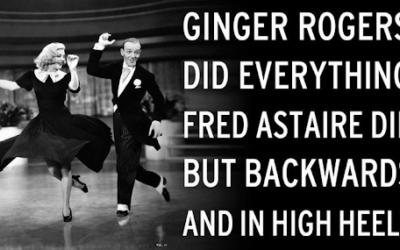Leaders sometimes scratch their heads and wonder why employees veer away from actions that support the organization’s mission. Stop scratching and start decoding this behavior with Christy’s insights into the power of organizational culture. – InPower Editors
I think you would agree that excellence is the goal for most individuals and organizations, but moving towards it is often a lengthy process full of ups and downs. While there may not be a “one size fits all” path to excellence, there are five traits that excellent organizations share. Once you implement these traits at your company will be well on its way to being one of the Excellent Organizations!
In my last post I discussed the importance of having a well-defined, accurately communicated, and universally accepted mission statement, but every now and then you’ll find some employees who know the mission, but act in direct opposition to it. Why would they do that? It’s simple, if the organization’s recognition and reward systems don’t match its stated mission, employees will lean toward the behaviors that are rewarded (the culture) as opposed to the stated desired behaviors that the mission would suggest.
That brings us to the second trait for excellent organizations: the culture of the organization must support the mission. Think of an organization that you believe is excellent—maybe an airline, an internet search engine, or a certain theme park that some would consider the happiest place on earth. When you think of those companies you can describe their culture. You know who they are, what they are working towards, and that their internal operations support their external goals.
As an example, many mission statements include words like “innovation” and “creativity,” but if there is a problem—and someone offers a new and slightly out-of-the-box idea—how should their manager respond? If the organization truly supports innovation, their idea should be welcomed, examined, and encouraged—BUT if their manager looks at them like they have two heads and tells them that they have obviously forgotten where they work, what will that employee do the next time they have an idea? Most likely, they will keep it to themselves and other employees will learn from their “mistake.”
[Tweet ” An organization’s culture is a driving force in helping employees decide what to do. via @Christysideas”]
That company has missed another opportunity to achieve mission statement excellence. Employees will wonder if they do what the paper says (mission) or do what the personality says (culture). An organization’s culture is a driving force in helping employees decide what to do. Your employee’s day-to-day decisions will help determine if your organization will experience excellence or hover in mediocre land.
How do you make sure your organization isn’t sending mixed messages? How do you ensure that your employees see a clear picture of what is expected of them so they can make decisions and perform accordingly? How do you make sure your culture matches your mission? There are a number of ways to do so, such as:
- Make sure that the employee behavior that is rewarded is the same behavior your mission statement supports.
- Make sure promotions and bonuses are based not only on doing a great job, but doing it in a way that promotesyour culture.
- Routinely engage in culture building activities such as “Spirit Week” if you have a fun and slightly playful culture; lunchtime team trivia games if your culture is one of collaboration; or an employee graffiti wall where employees can draw or whiteboard ideas, concepts, and random thoughts to share with the rest of the company, if your culture is one of innovation and creativity.
- Ask as many “why?” questions as you do “what?” questions
At some point, we’ve all heard someone say, “Do what I say, not what I do.” Truly excellent organizations do both. All members of the organization understand the stated rules (mission statement) as well as the unstated, but vitally important norms (culture).
[Tweet ““Do what I say, not what I do.” Truly excellent organizations do both. via @Christysideas”]
While we prepare to discuss the final three traits of Excellent Organizations, please share some of your mission statement and company culture stories. What experiences have you had with highly successful, well understood missions and supportive cultures? What downsides have you noticed when either the mission isn’t clear or your culture works against your stated goals?
Please look for my future posts on the remaining 3 traits of an excellent organization.






